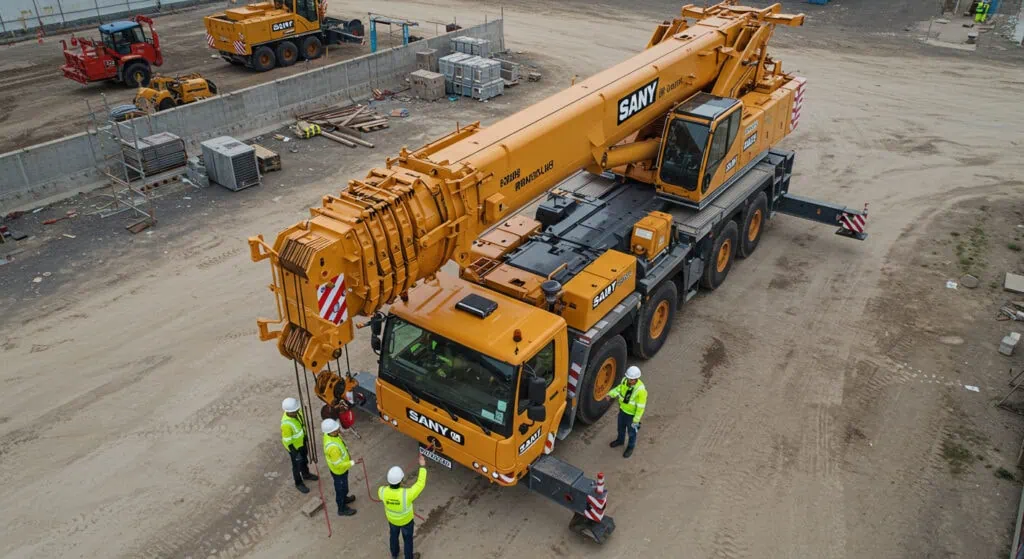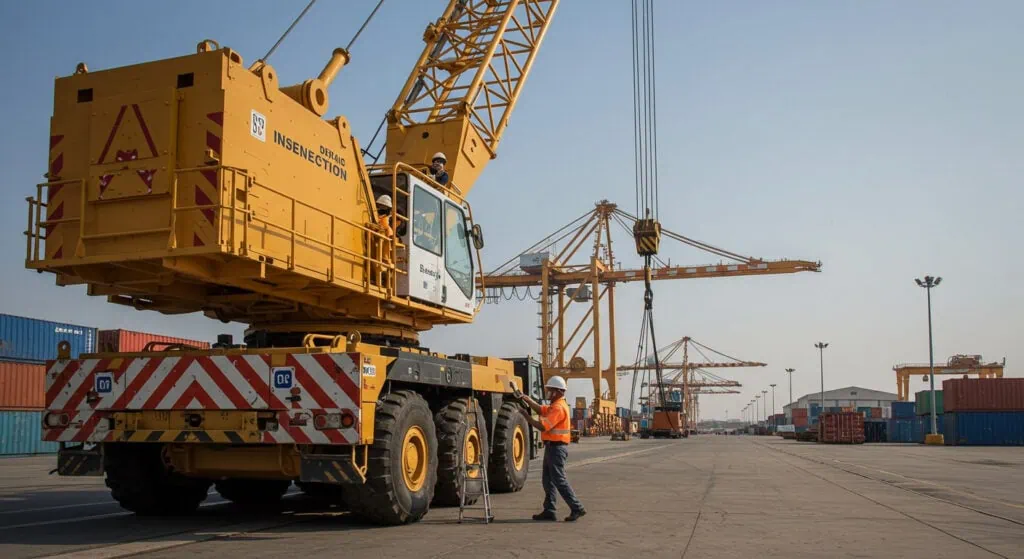Ensuring the quality and performance of a crane is essential when making a purchase. Purchasing a crane with unreported problems may result in expensive repairs or, worse, hazardous operating circumstances. The main inspection criteria you should take into account before making your purchase will be emphasized in this post.
Before purchasing a crane, it’s essential to evaluate its condition thoroughly. Key areas such as the structure, hydraulic system, and electrical systems must be checked to avoid costly repairs. This article will guide you through each critical step in crane inspection.
Let’s look at the major variables to consider during a crane inspection so that you can make an informed selection before purchasing.

Table of Contents
Toggle1. What to Check During Crane Inspection?
This includes inspecting the gears for wear or breaks in the teeth. This is especially important after somebody overloads the crane because it can wear out the gears. So do the proper inspections to keep the crane safe, working correctly on the job site, and to avoid harming somebody.
On your crane, you will mainly focus on the construction and the hydraulic system inside the crane. You will inspect the lifting arm, the boom, or whatever they use to lift stuff on and off the truck. You need to make sure the mechanical parts of your crane operate correctly. A well-built crane does not meet safety standards. Check the hydraulic system, but also check everything else to ensure the crane functions properly and is safe on the job site. That way you don’t harm anybody or have to answer any questions because you could not take two minutes to do step number one in the cheat sheet.
You need to check the construction and the hydraulic system inside the crane. You need to check the lifting arm, boom, or whatever they use to lift stuff on and off the truck. You need to make sure the mechanical parts of your crane work. A well-built crane means nothing. It does not mean it meets safety regulations or will work for your needs. Check the hydraulic system, check the engine and the gears in the bottom of the crane, and check the lift mechanism.
| Component | Elenco di controllo dell'ispezione | Common Issues |
| Crane Structure | Check for cracks, corrosion, or bent parts in the frame and booms. | Rust, cracks, deformation, or wear. |
| Hydraulic System | Ensure hoses and pumps are working correctly, check for fluid leaks. | Leaks, low pressure, damaged seals. |
| Electrical System | Test all control systems and wiring for functionality. | Faulty wiring, malfunctioning sensors. |
| Lifting Mechanism | Ensure the lifting arm is structurally sound, check for cracks, wear, or misalignment. | Bent or broken parts, oil leaks. |
| Engine & Transmission | Test the engine performance, check fluid levels, and inspect the gearbox for issues. | Engine noise, transmission issues. |
2. How to Inspect the Crane’s Hydraulic System?
A crane inspection checks the hydraulic system. This is important because the hydraulic system raises and lowers the stuff you lift with the crane. If you have a problem with the hydraulic system, you have a problem with the crane. If you run something through the hydraulic lines you shouldn’t have, you will have to replace that line. Run the crane without oil, and everything locks up. Why have the problem? Be sure it works when you need the crane to lift something heavy onto the truck.
To inspect the hydraulic system, check the hydraulic fluid for contamination, test the pressure in the lines, and make sure there are no leaks. Pay particular attention to the hydraulic cylinders and seals.
The hydraulic components must be thoroughly examined during a proper crane inspection. First, inspect the hydraulic oil level and quality; unclean or low hydraulic oil may suggest an issue. Next, check the system’s pressure to confirm it fits the criteria. Leaks in hoses, pumps, and valves should be found and corrected as soon as possible to avoid operational failure. Inspect hydraulic hoses for cracks, abrasions, and loose couplings. The table below contains a detailed guide for inspecting hydraulic systems.
| Hydraulic Component | Elenco di controllo dell'ispezione | Common Issues |
| Hydraulic Oil | Ensure oil is clean, at the proper level, and free of contaminants. | Contaminated, low, or old oil. |
| Hydraulic Hoses | Check for cracks, abrasions, or leaks in hoses and fittings. | Leaks, cracked or damaged hoses. |
| Hydraulic Cylinders | Inspect cylinders for bends, cracks, or leaking seals. | Worn seals, cracks, leakage. |
| Pump & Valves | Test the pump pressure and check valves for proper operation. | Low pressure, malfunctioning valves. |

3. Why is the Crane’s Load Test Important?
The load test is one of the most important aspects of crane inspection. It ensures that the crane can safely lift the loads for which it was intended, which is critical for on-site safety.
During a load test, confirm that the crane can carry its maximum load without problems. Keep an eye out for any unusual motions, sounds, or instability when the crane is loaded.
A load test confirms that the crane is capable of safely lifting the maximum weight specified by the manufacturer. The test should be done in a controlled environment, and the crane should not show any signs of instability, unusual movements, or strain under load. The crane’s stability should also be evaluated to ensure that it can handle lateral forces. The table below summarizes key points to check during a load test.
| Test Parameter | Elenco di controllo dell'ispezione | Signs of Concern |
| Load Capacity | Test the crane at its maximum rated load capacity. | Unstable movements, sagging. |
| Lift Operation | Observe smoothness of the lift operation and check for any abnormal movements. | Jerky movements, abnormal vibrations. |
| Structural Integrity | Inspect the crane frame and lifting arm during the test for any signs of bending or cracks. | Frame bending, cracking under load. |
| Hydraulic Pressure | Ensure the hydraulic system maintains consistent pressure throughout the test. | Pressure drops, leaks under load. |
4. How to Evaluate the Crane’s Electrical Systems?
Many parts of the crane inspection, such as lifting control and safety measures, are managed by its electrical system. Operational difficulties or safety risks may arise from a malfunctioning electrical system.
Examine the control panels, sensors, and electrical wiring for wear and tear, and make sure that all electrical parts are corrosion-free and operating as intended.
Crane inspection requires a close examination of the electrical systems. Examine the wiring for indications of deterioration or wear, such as frayed cables or exposed connections. Make that all of the crane’s controls and sensors are functioning properly by testing them. To make sure there are no short circuits or malfunctions, pay close attention to the state of the electrical relays, fuses, and battery. A checklist for evaluating the crane’s electrical system is provided in the table below.
| Electrical Component | Elenco di controllo dell'ispezione | Common Issues |
| Wiring & Connections | Check for exposed or damaged wiring and poor connections. | Frayed wires, loose connections. |
| Sensors & Controls | Test the responsiveness of all safety sensors and control buttons. | Non-responsive sensors, faulty switches. |
| Battery & Relays | Check the battery charge and the condition of relays and fuses. | Corroded battery terminals, faulty relays. |
| Circuit Protection | Ensure that the electrical circuit protection devices are functioning properly. | Tripped breakers, blown fuses. |

5. What are Common Issues Found in Used Cranes?
Used cranes, especially older versions, might have a range of difficulties that might not be immediately obvious. These flaws could generate unanticipated downtime or safety concerns.
Worn-out lifting arms, defective hydraulic systems, and electrical faults are all common difficulties with old cranes. Before purchasing a crane, conduct a thorough check to discover any issues.
One of the most common problems with used cranes is wear and tear on the lifting arm, which can cause operational instability; worn hydraulic pumps and valves can drastically reduce the crane’s lifting capacity and performance; electrical faults, such as malfunctioning control systems or wiring issues, are also common and can result in dangerous situations; and hydraulic leaks, worn-out lifting components, or electrical failures are just a few of the many challenges that used cranes can present.
| Common Issues | Elenco di controllo dell'ispezione | Impact on Performance |
| Worn Lifting Arms | Inspect for cracks, rust, or deformation. | Reduced lifting capacity, instability. |
| Hydraulic Leaks | Check hoses, pumps, and seals for signs of fluid leakage. | Lower performance, potential failure. |
| Electrical Failures | Test control systems and wiring for wear and malfunctions. | Operational hazards, safety risks. |
| General Wear and Tear | Inspect for general wear on various crane components. | Frequent repairs, operational inefficiency. |
6. How to Check the Crane’s Overall Condition?
Assessing a crane’s general condition is crucial before making a purchase. This entails examining not just specific parts but also the crane’s maintenance and operation history.
Visually inspect the crane’s exterior, looking for dents, cracks, and other physical damage. In addition, study the maintenance records to determine how effectively the crane has been cared for.
The following table lists the most important things to look for when assessing a crane’s condition: a thorough examination of the crane’s appearance and functionality; a look for physical damage, such as dents, cracks, or bent components; a check for rust, which may indicate poor storage conditions; and the maintenance records, which offer important information about how well the crane has been cared for, allowing you to determine whether it has been neglected or properly maintained.
| Condition Factor | Elenco di controllo dell'ispezione | Common Issues |
| Physical Damage | Inspect for dents, cracks, or bent parts in the crane’s frame and booms. | Structural weaknesses, corrosion. |
| Maintenance Records | Review the crane’s maintenance logs for history of repairs, parts replacements, etc. | Neglected maintenance, irregular service. |
| Operational History | Evaluate how frequently and intensely the crane was used. | Overuse, improper handling. |
| Exterior Condition | Inspect for rust, chipped paint, or scratches. | Rust, weather damage. |

7. What Documents Should You Verify Before Purchasing a Crane?
Make sure that all necessary paperwork is in order before completing a crane purchase. These records may provide important details regarding the crane’s background, current state, and legal standing.
Before purchasing a crane, check its certification, maintenance records, and ownership documentation to ensure that it is legal, well-maintained, and appropriate for your requirements.
The crane’s registration papers, maintenance logs, inspection certifications, and any warranties or guarantees are among the crucial documents to confirm. The crane’s compliance with safety and operating standards is guaranteed by the certification. While ownership documentation confirm that the crane has been lawfully transferred, maintenance records offer information about the crane’s care. We have listed the most crucial documents to review in the table below.
| Document | Elenco di controllo dell'ispezione | Importance |
| Registration Papers | Ensure the crane is properly registered with the relevant authorities. | Legal compliance, proof of ownership. |
| Maintenance Records | Review the history of repairs, replacements, and inspections. | Verification of proper upkeep. |
| Certification | Check for compliance with safety and operational regulations. | Safety assurance, legal compliance. |
| Warranty/Guarantee | Confirm any warranties or guarantees that apply to the crane. | Financial protection, coverage for repairs. |
8. How to Assess the Crane’s Safety Features?
When operating a crane, safety is the number one priority, and it is critical to ensure that the crane’s safety systems are functioning properly. A thorough assessment of these characteristics assures safe operation and protects workers on the job site.
Check for important safety features such as anti-two-block systems, load moment indicators, and emergency stop functions. These features avoid mishaps and keep the crane operating within its safe limits.
The crane’s safety mechanisms are intended to avoid accidents and guarantee that it operates within safe limitations. Important safety features to check include:
Anti-Two-Block System: This feature prevents the crane’s hook block from making contact with the boom, lowering the possibility of crane damage or catastrophic failure.
Load Moment Indicator (LMI): The LMI system monitors the crane’s load and prevents overloading by warning the operator when the crane approaches its maximum capacity.
Emergency Stop System: Check sure the emergency stop function is operational and can promptly cease crane operations in the event of an emergency.
Overload Protection: Check that the crane has overload prevention systems that will immediately stop it from lifting above its capability.
Table for Safety Features:
| Safety Feature | Elenco di controllo dell'ispezione | Importance |
| Anti-Two-Block System | Check for proper installation and functionality of the anti-two-block device. | Prevents boom damage and crane malfunction. |
| Load Moment Indicator | Test the LMI for accurate load readings and alert systems when the crane is overloaded. | Ensures the crane doesn’t exceed safe lifting limits. |
| Emergency Stop System | Test the emergency stop button to ensure quick shutdown of crane operations. | Vital for immediate halting in emergency situations. |
| Overload Protection | Verify that the crane stops lifting automatically when it exceeds its rated load. | Prevents crane damage and safety hazards. |

9. How to Verify the Crane’s Operational Capacity?
To ensure the crane will suit your specific operating needs, it’s necessary to test its capacity for lifting, reach, and general functionality. Understanding these elements will help you make an informed decision based on your project requirements.
To decide if the crane meets your operating requirements, consider its lifting capacity, reach, and maximum working height. Load tests and technical documents can be used to verify the crane’s capabilities.
To make sure a crane can meet the demands of your projects, it is essential to confirm its operational capacity. A number of important things must be taken into account:
Lifting Capacity: To find out how much weight the crane can safely carry at different boom lengths and angles, check its rated lifting capacity. This is frequently mentioned in the load charts for the crane.
Reach and Boom Length: The reach, or the distance the crane’s boom can extend horizontally, is critical for projects needing the crane to lift big loads across great distances.
Maximum Working Height: Determine the crane’s maximum lift height, which is critical for construction projects involving high-rise structures or elevated work areas.
Load Testing: Verify the crane’s lifting capabilities through thorough load testing to guarantee that it can manage the intended load without fail.
Table for Operational Capacity:
| Operational Factor | Elenco di controllo dell'ispezione | Importance |
| Lifting Capacity | Check the crane’s load charts to verify the maximum lifting capacity at different boom lengths. | Ensures the crane can safely handle the required loads. |
| Reach and Boom Length | Measure the crane’s reach to ensure it can extend far enough for your specific needs. | Important for lifting loads over long distances. |
| Maximum Working Height | Verify the crane’s maximum working height for projects involving tall structures. | Ensures the crane can reach sufficient height for your tasks. |
| Load Testing | Perform or review load tests to verify the crane’s lifting capabilities. | Confirms that the crane can lift at its rated capacity safely. |
Summary:
You can make sure you’re buying a crane that is safe, dependable, and suitable for your purposes by carefully examining the important parts and confirming pertinent documentation. By taking a comprehensive approach to crane inspection, you may avoid possible safety risks and save a lot of money. If you need more information about crane inspection, crane inspection checklist pdf,crane inspection requirements,crane inspection course,crane daily inspection checklist,overhead crane inspection, how often does a periodic crane inspection occur,when should a frequent crane inspection occur,mobile crane inspection, please feel free to contact with us.
Our company provide the Sany and Xcmg brand Crane truck with different weight,if you have any questions, you could leave me message.